This article lists 72 blogging ideas you can write about to jump-start your content creation efforts—regardless of your industry.
We organized our list into seven main blog types to make it easy to focus on what matters most to you.
Plus, we’ve included an example blog post for each category. So you can see how other businesses apply these ideas to their own industries.
Let’s dive in.
Thought Leadership Blog Ideas
- Analyze the top [topic] trends of the year
- Respond to news stories related to [topic]
- Write about the latest technological developments in your industry
- Make predictions about how your industry will change
- Weigh in on an industry controversy
- Create an industry report with original research
- Reflect on major industry changes that happened at the end of the year
- Discuss ethical questions related to [topic]
- Identify a problem your industry is facing and propose a solution
Thought Leadership Blog Post Example
This thought leadership post from the Academy to Innovate HR covers the top human resource trends of the year.

And Semrush’s Backlink Analytics tool shows that many people have shared the post—it has nearly 1,000 backlinks (e.g., links from other sites).
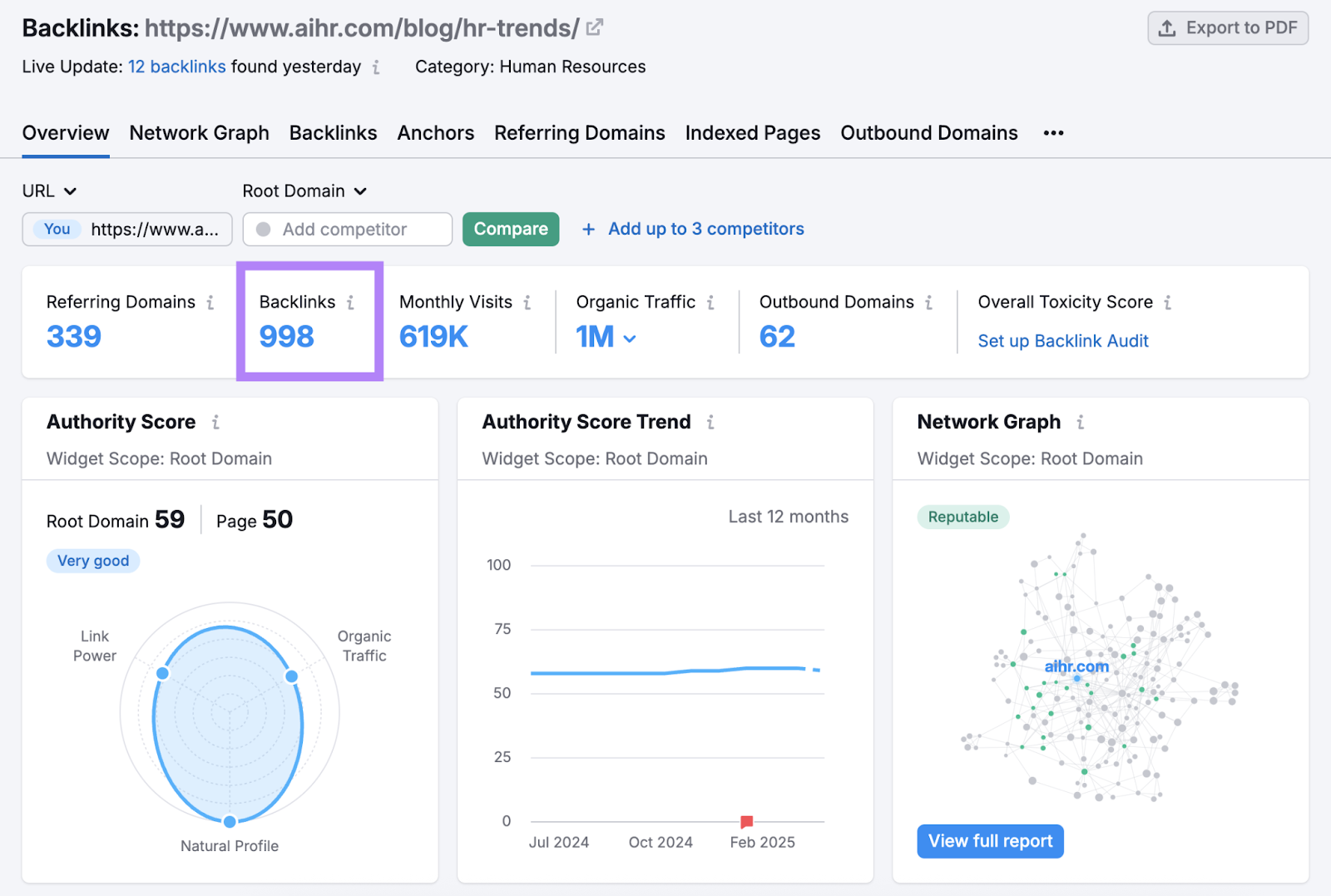
Which is good for the site’s SEO and drives referral traffic to the page.
Here’s what the post does well (and what you can emulate):
- Incorporates rich media like video, images, and infographics
- Is authored by subject matter experts, whose credibility is showcased in detailed author bios
- Includes statistics (and links) to primary sources
Experience-Driven Blog Ideas
- Tell your entrepreneurship story
- Interview successful people in your industry
- Showcase your past work with customers or clients (i.e., case studies)
- Share your opinion on current [topic] debates
- Offer advice to newcomers in your industry
- Share your favorite productivity tips
- Detail a day in your life
- Share networking tips for your industry
- Create a pros and cons list about your career field
- Discuss challenges you’ve faced growing your business and how you’ve overcome them
- Share your favorite social media posts about [topic] from the year
- Discuss the top lessons you’ve learned about [topic] in your career
Experience-Driven Blog Post Example
This post from Boss Girl Bloggers features tips, advice, and real-world examples from the author on how she monetized her blog.

It incorporates examples from the author’s entrepreneurship journey and offers personal recommendations.
Experience-driven blog posts like this are relevant to other people in your industry. Plus, they often do well on social media, where creator authenticity is important for engagement.
For example, this post got several shares and likes when it was posted to X:
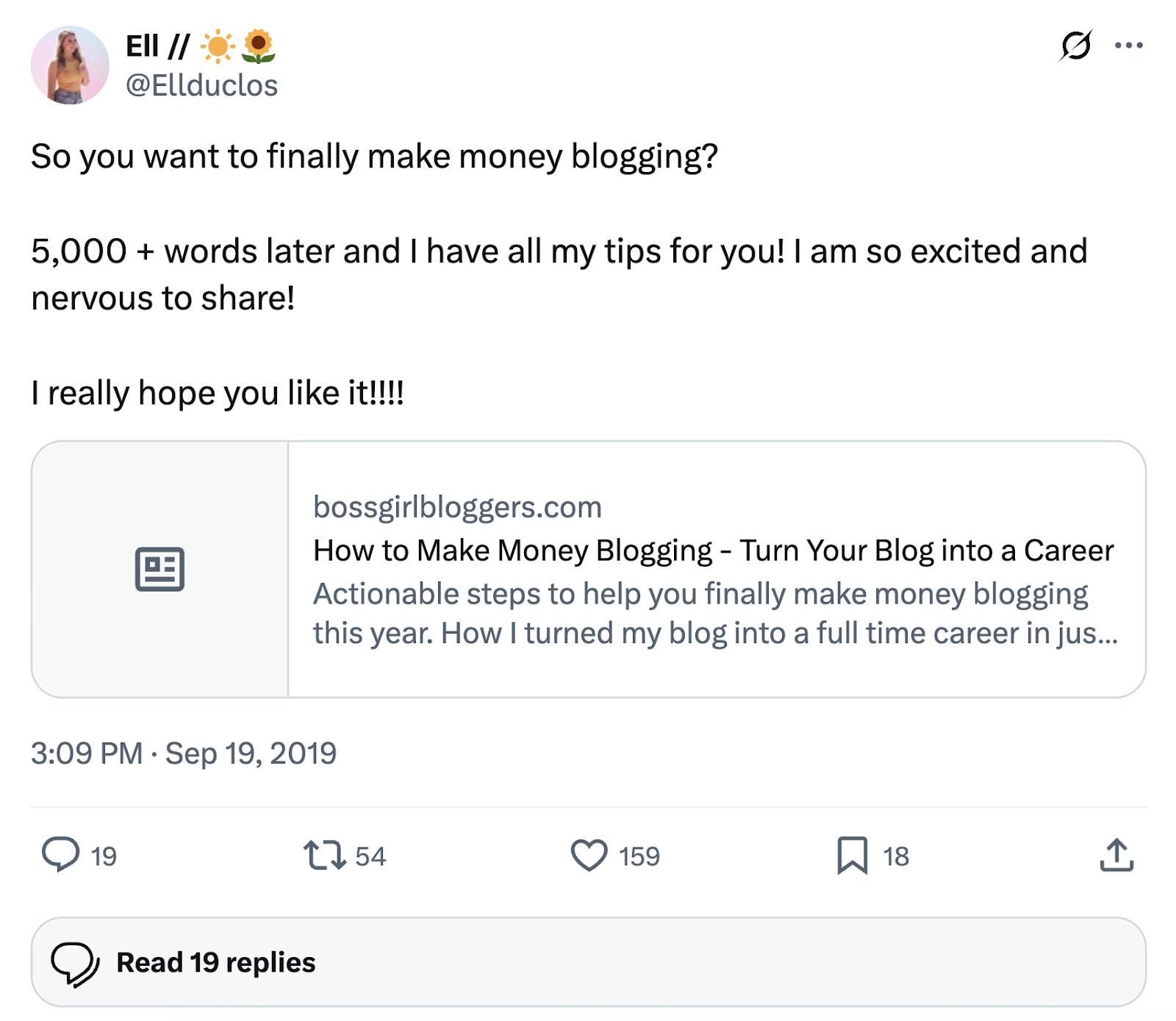
Educational Blog Ideas
- List common mistakes with [topic] and how to avoid them
- Debunk common myths about [topic]
- List lesser-known facts about [topic]
- List do’s and don’ts about [topic]
- Offer advice on how to stay competitive and win in your industry
- Explain how to become a [topic-relevant profession]
- Compile a list of insights from industry experts
- Define important concepts related to [topic] and what to know about each
- Answer frequently asked questions about [topic]
- Compile a list of statistics about [topic]
- Discuss how AI is impacting [topic]
- Write how-to guides for common industry tasks that include helpful checklists
- Create step-by-step guides related to [topic]
Educational Blog Post Example
The University of Florida’s Online Master of Science in Sport Management program created this educational blog post on how to become a sports agent.
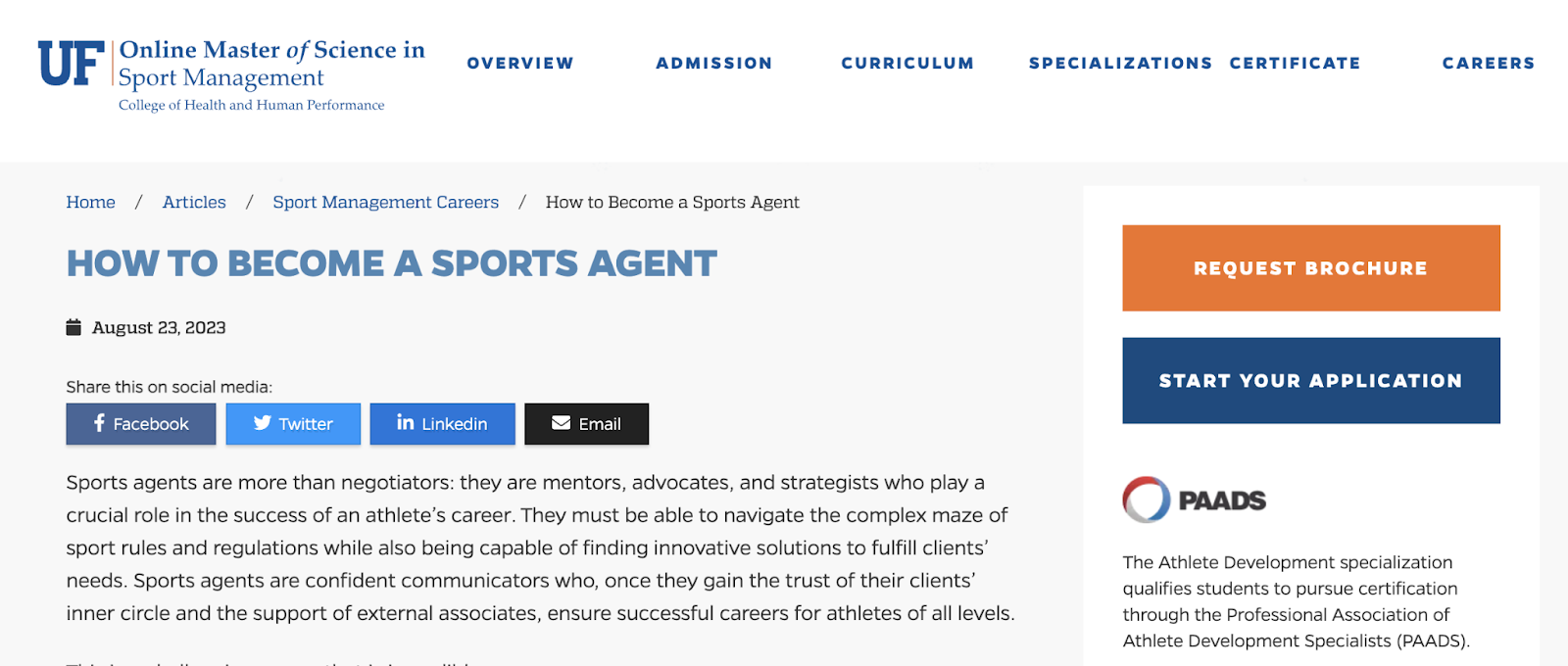
And Organic Research shows that it ranks (appears in search results) for 270 keywords. And gets about 1,400 organic visits per month.

Here are some things that may be helping the post rank well:
- It includes question keywords related to the topic and provides detailed answers for each
- It offers a step-by-step process that’s easy for readers to follow
- It has related keywords in the header tags, increasing the total keywords the page can rank for
Promotional Blog Ideas
- Announce new products or services you’re launching
- Post press releases about major company news
- Compare your product or service with a competitor’s
- Co-create content with partners to highlight their complementary products/services
- Create step-by-step guides for how to use your products or services
- Spotlight individual products or features and how they can be used
- Repurpose promotional webinars into blog posts
- Summarize news articles or press coverage of your business
- Compile a list of positive customer testimonials
- Highlight impressive end-of-year numbers about company successes
- Report on any charitable donations your business has made
Promotional Blog Post Example
This blog post from Tesla recaps the financial investments they made in the state of Nevada a few years ago and includes specific figures related to production.
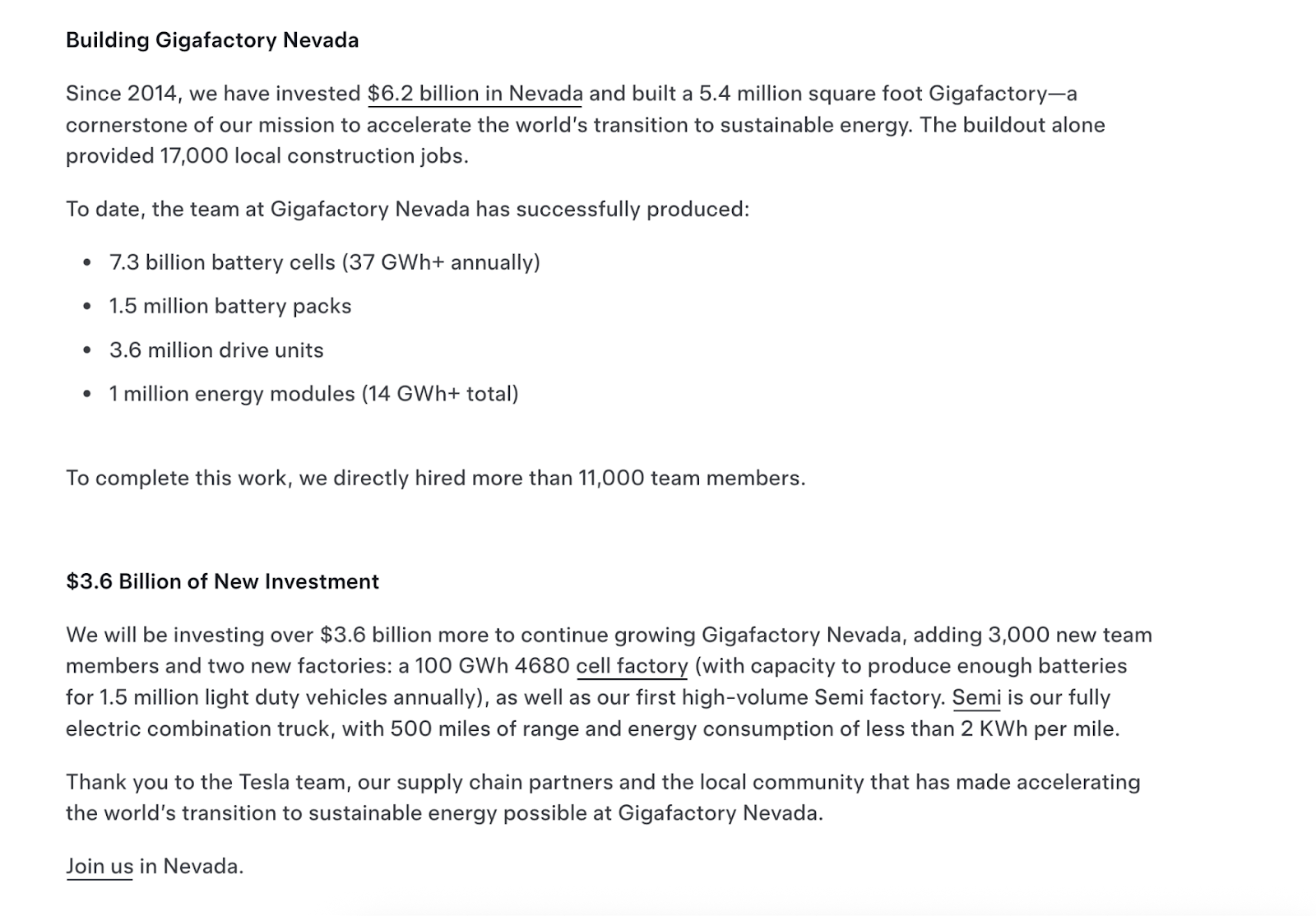
Backlink Analytics shows that over 560 domains have linked to the post. Including authoritative news outlets like The New York Times.
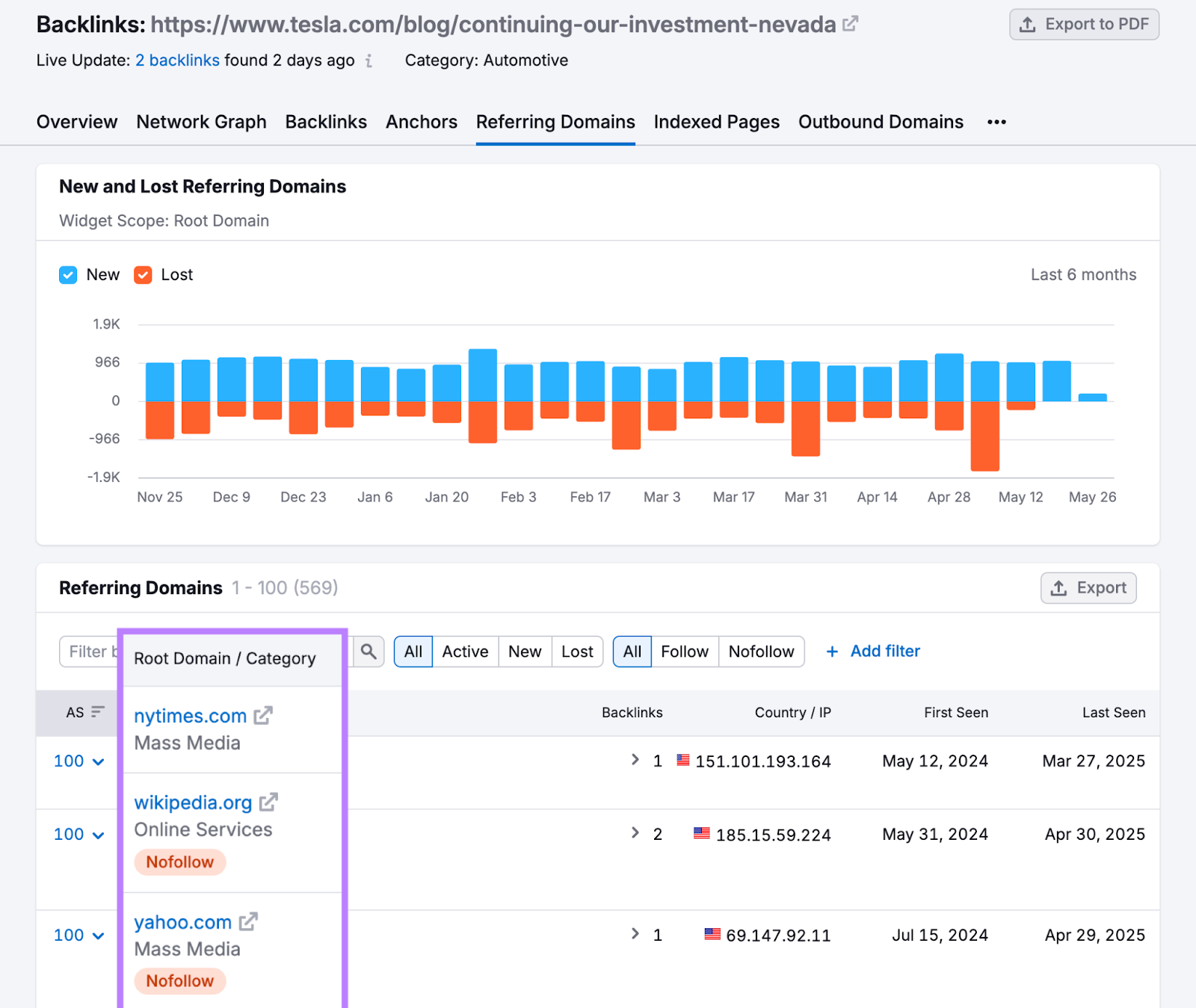
Promotional posts like this can be great as part of a digital PR strategy. Because journalists who cover your industry may want to include your post in their coverage.
Brand-Building Blog Ideas
- Introduce members of your team via profiles or interviews
- Tell the story of your company’s founders
- Detail your company values or mission statement
- Create a timeline about your company’s growth
- Discuss social initiatives at your business (e.g., sustainability, diversity, etc.)
- Tell stories about your company culture or workplace
- Offer hiring or department-specific updates
- Share monthly recaps highlighting important happenings
- List humorous GIFs related to [topic]
Brand-Building Blog Post Example
Piper created this timeline of their company history, which positions them as innovators in their aviation niche.

Organic Research shows that the post ranks for a variety of branded searches.
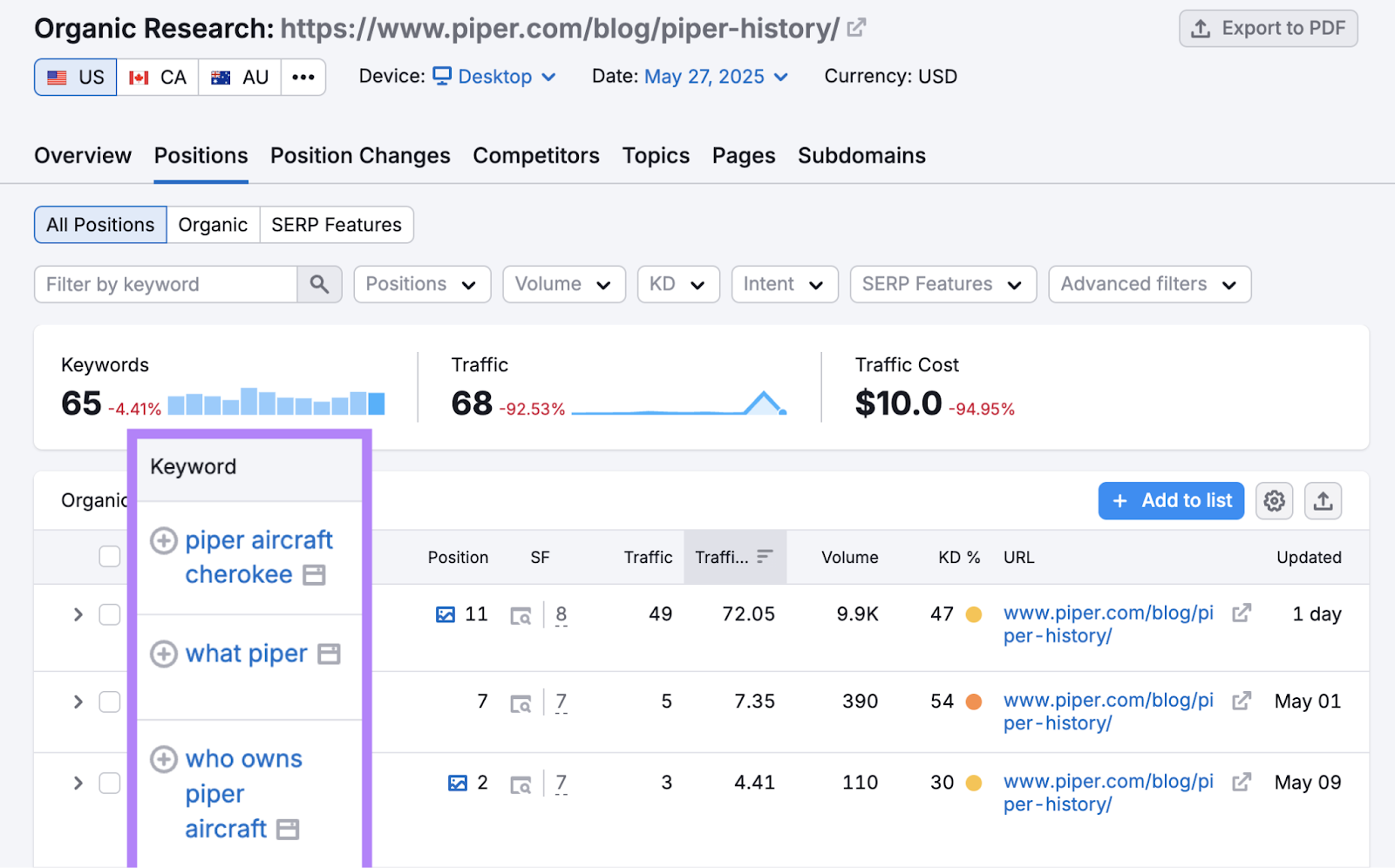
When people research Piper online, they might discover this blog post that highlights the company’s innovations and accomplishments.
Which may influence their purchase decisions later on.
Helpful Resource Blog Ideas
- Share the top podcasts in your industry
- List the top YouTube Channels about [topic]
- Create a glossary of industry terms or abbreviations
- Find influencers in your industry and share the best ones to follow
- Compare and contrast similar products or services
- Compile a list of Facebook groups related to [topic]
- List the best books for learning more about [topic]
- Compile a list of courses about [topic]
- Provide templates for key documents
- List the best blogs about [topic]
- Share a list of newsletters related to [topic]
Helpful Resource Blog Post Example
Housing Wire published this list of the best real estate podcasts and included brief explanations of who can benefit from them.

We can see in Organic Research that it ranks in top positions for some keywords with pretty high search volumes.
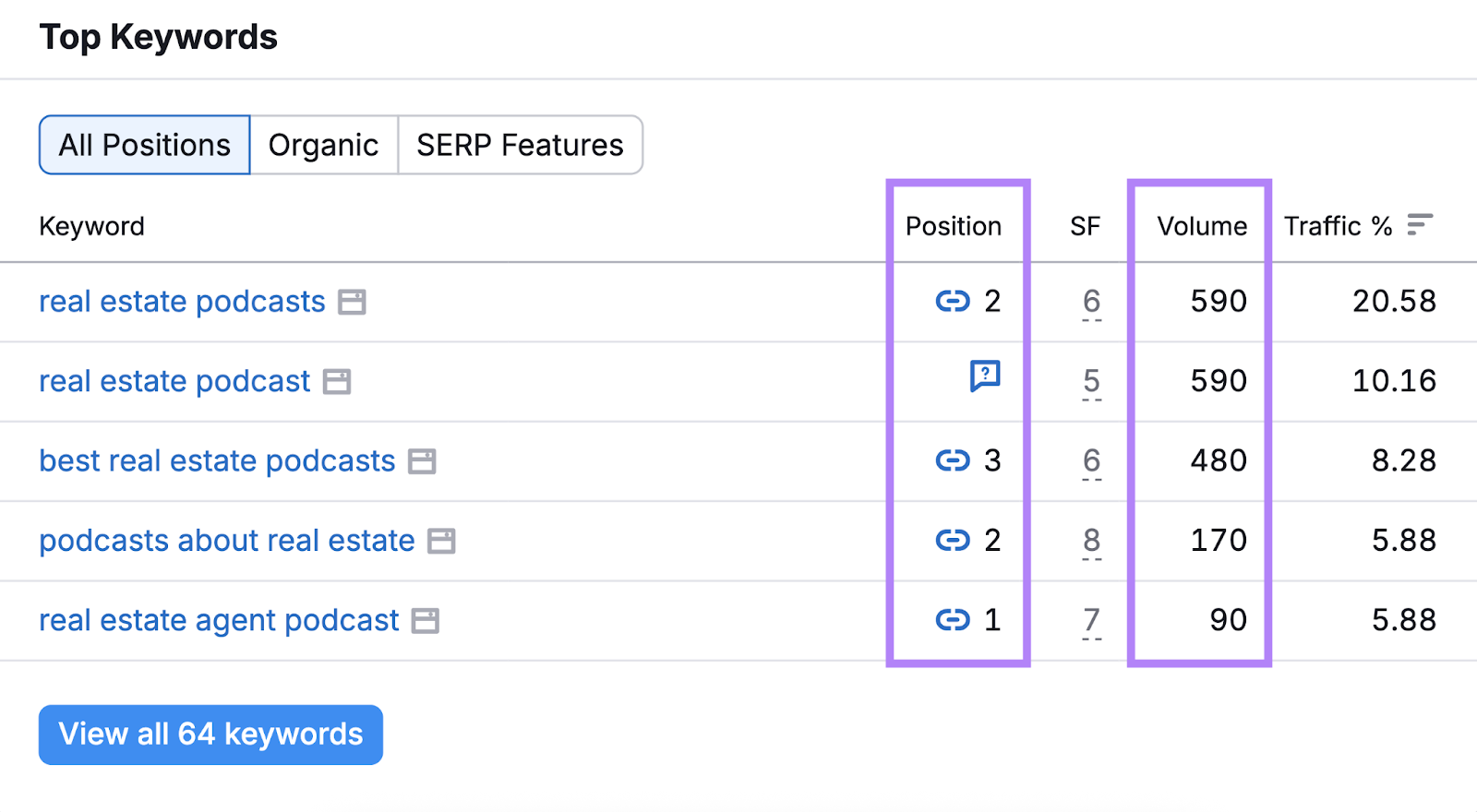
It has several qualities that increase the post’s helpfulness, including:
- External links to each of the resources. Which makes it easy for readers to check them out.
- A podcast image, title, and host name, so readers have the most important information
- Industry expertise with “Why it’s great” sections that analyze how the resources are actually helpful
Event-Specific Blogs
- Compile a list of industry conferences or events
- Assemble a timeline of important events related to [topic]
- Recap community or industry events you’ve participated in
- Share a transcript from a conference or event you presented at
- List key takeaways from [event name]
- Repurpose a talk you gave into another format
- Provide commentary on someone else’s presentation
Event-Specific Blog PostExample
CapitalPlus Financial Services created this comprehensive list of construction trade shows and events, which is highly relevant to their target audience of contractors.
While not exactly a blog post, the format would work for most companies’ blogs.
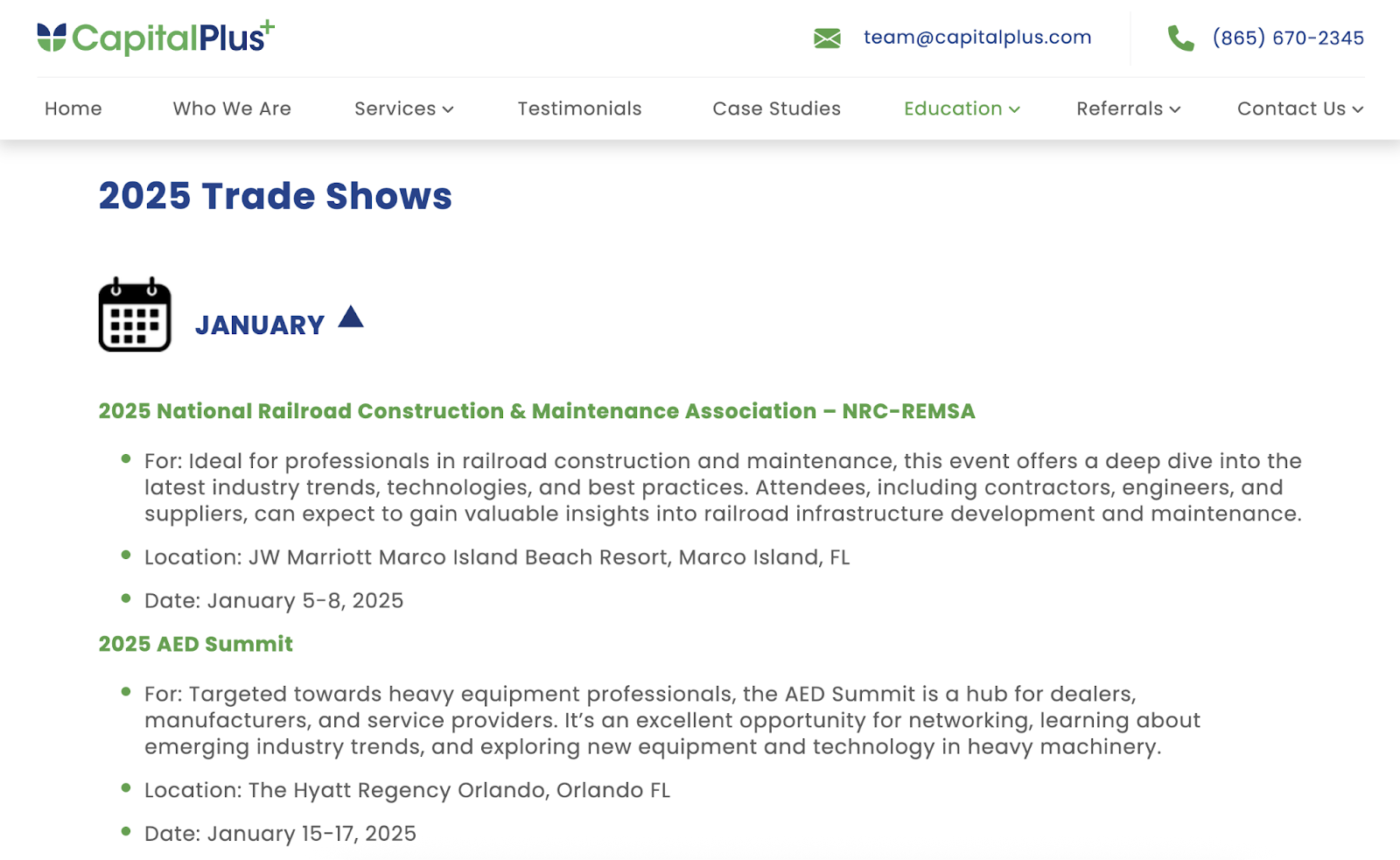
It includes the most important information about each event, including the name, location, and date. And jump links at the top of the page make it easy for users to find an event in the month they want to attend one.
Posts like this can also be updated annually to keep them relevant.
We can see in Organic Research that this page has ups and downs in traffic. But it still generates visits because it has been updated for 2025.
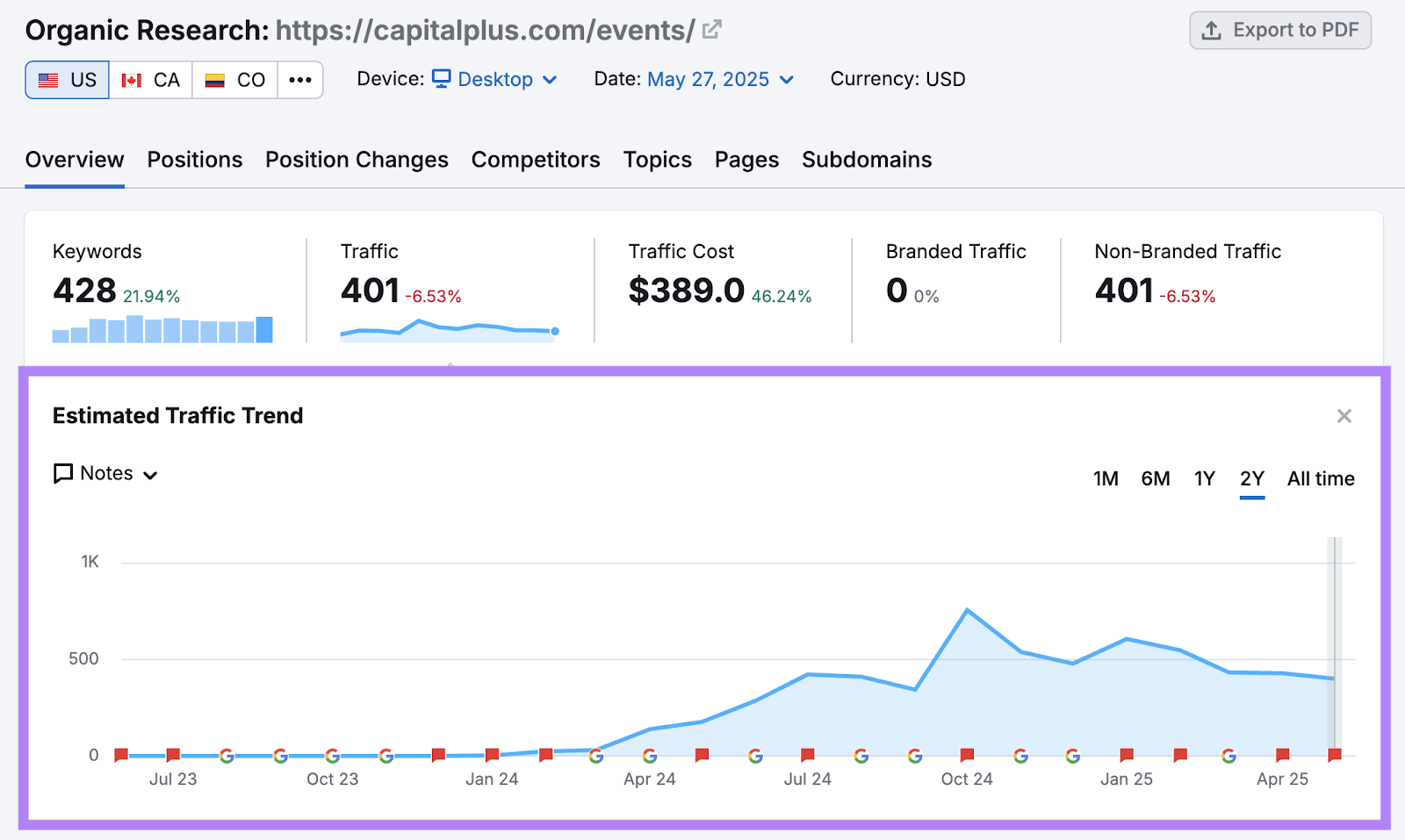
How to Find Ideas for Blogs
Here are some ways to find blog content ideas that are specific to your business or website.
Review Google Autocomplete Suggestions
A free way to find blog ideas is by typing a topic into the Google search bar and reviewing what populates beneath it.
Like this:
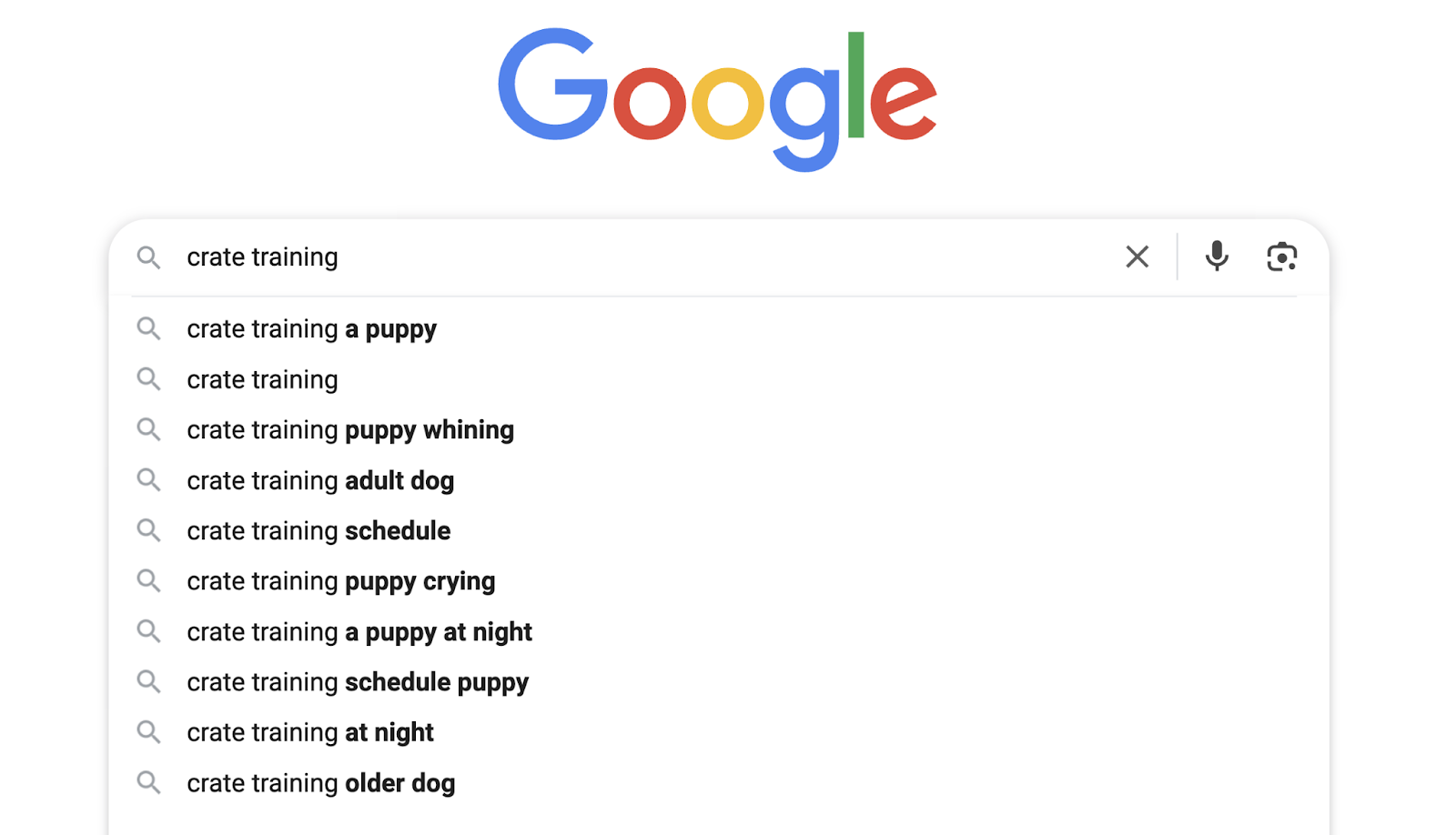
Google generates autocompletes based on multiple factors, including what other users have searched and trending topics. So, you can be confident there’s wide user interest in those topics.
Complete as many searches as you want to get more ideas. And keep track of any topics you might want to cover.
Research Competitors’ Blogs
Another free way to get blog topic ideas is by researching competitor websites in your industry.
To find competitors, search for a topic in the search bar and see what sites are ranking on search engine results pages (SERPs)—focus on the top 10 or so.
If you already know your competitors, use these advanced search operators in Google to see what specific topics they’ve covered on their blogs:
- site: Restricts search results to a specific website
- inurl: Narrows search results to pages with specific words in the URL
Let’s say you search “site:bamboohr.com/blog.” You’ll get a list of pages on BambooHR’s blog.
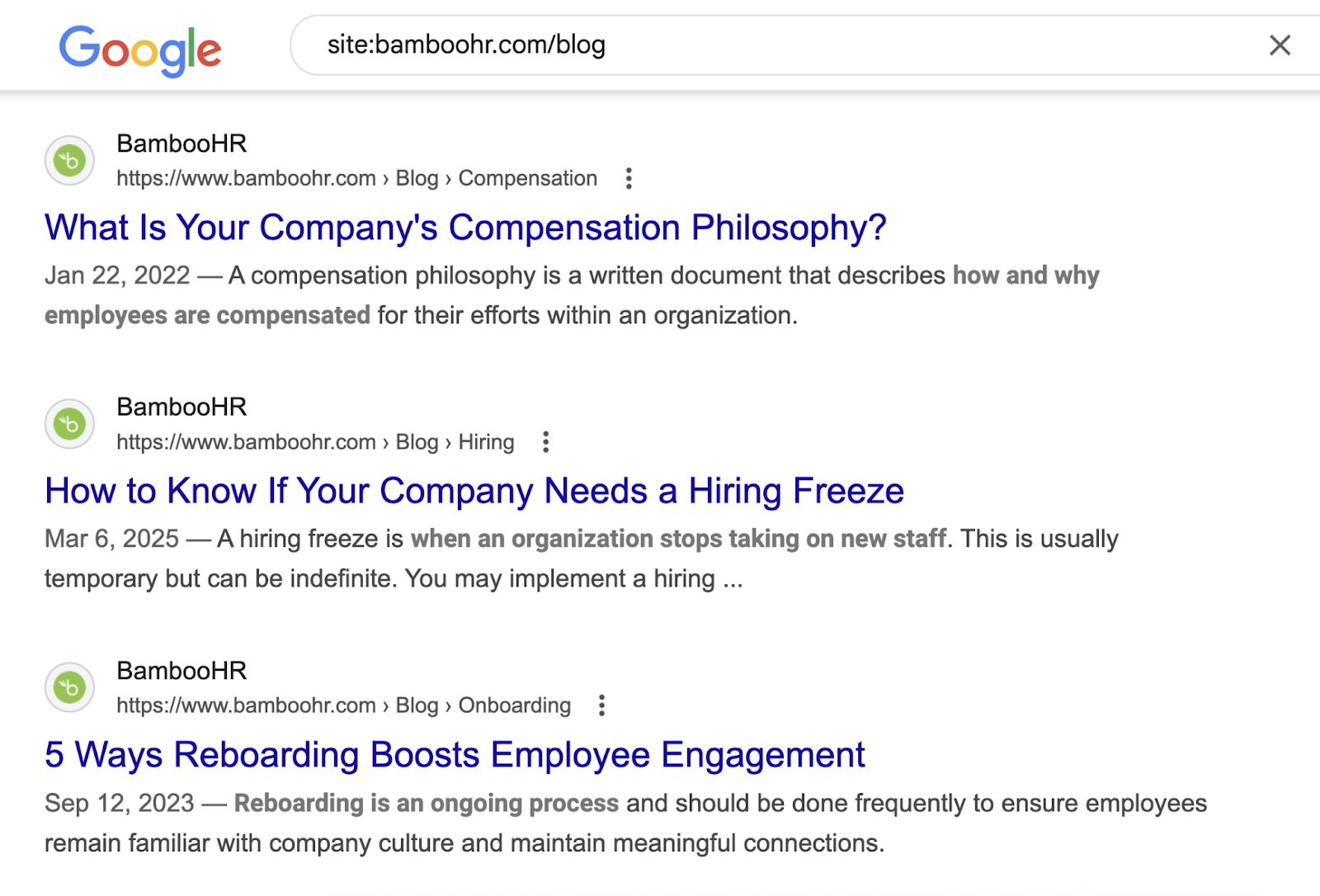
Browse the search results to see the exact topics the competitor has covered on their blog. And use those ideas as inspiration for your posts.
Prompt ChatGPT
ChatGPT will quickly generate blog ideas relevant to your industry and areas of expertise, as long as you prompt it correctly.
So, use this prompt for unique blog ideas. And make sure to personalize it with your focus area, blog type, tone of voice, and target audience.
“Based on the provided information, generate a list of five potential blog post titles that would be interesting and relevant to the target audience. Include specific angles to cover and a brief outline of each post.
Topic Area: finance
Blog Type: educational
Tone: conversational
Target Audience: college students”
Here was the output for the above prompt:
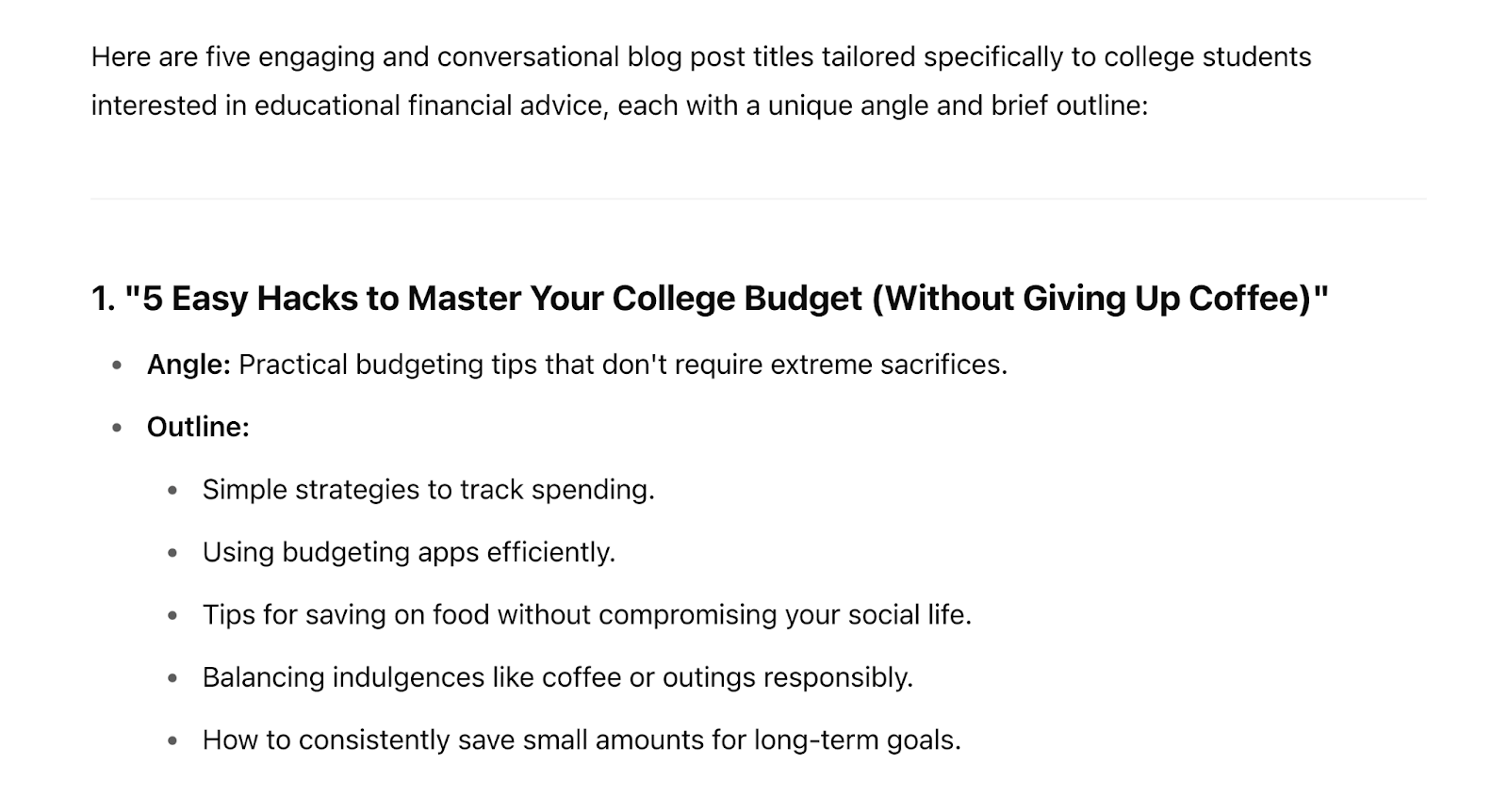
What you get from ChatGPT will depend on how you prompt it. Being more specific (or changing the prompt values) may help you get ideas that are more relevant to your business.
Use the Topic Research Tool
Semrush’s Topic Research tool shows you ideas others have covered on their websites based on a main topic.
Enter a topic related to your business, select your target location, and click “Get content ideas.”
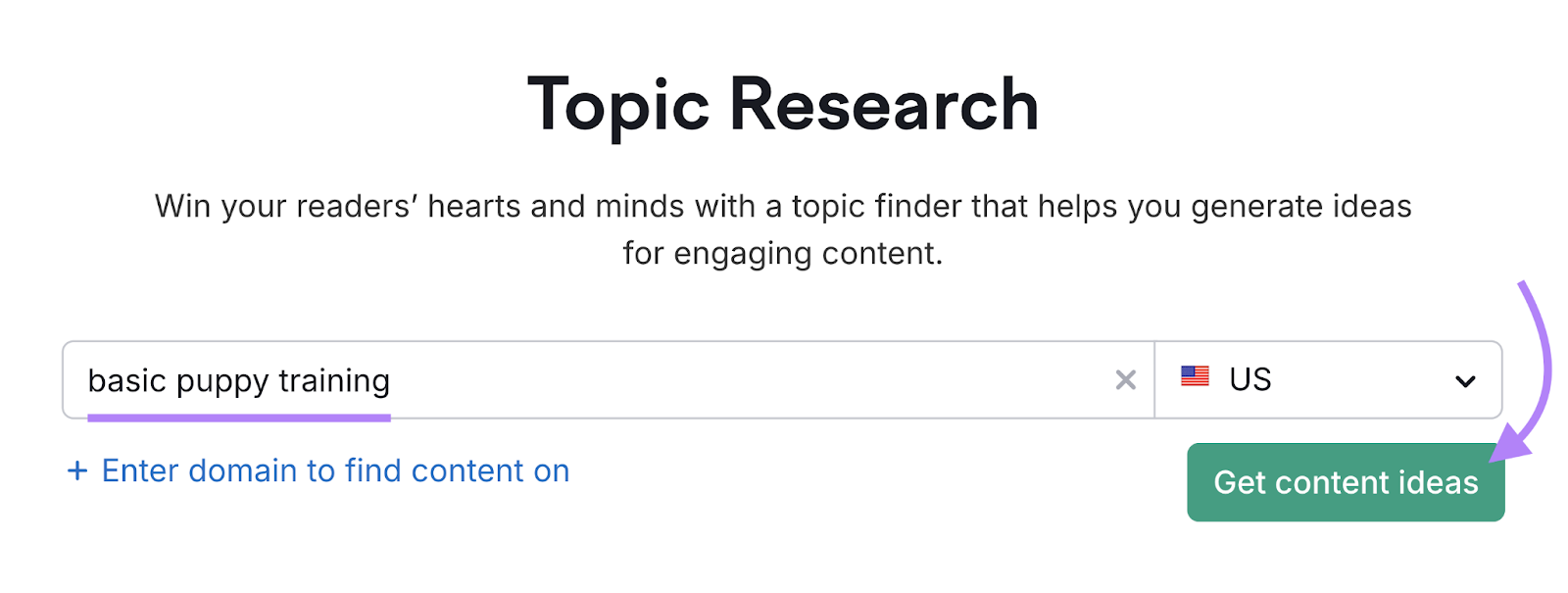
You’ll get a list of subtopics related to your starting term.
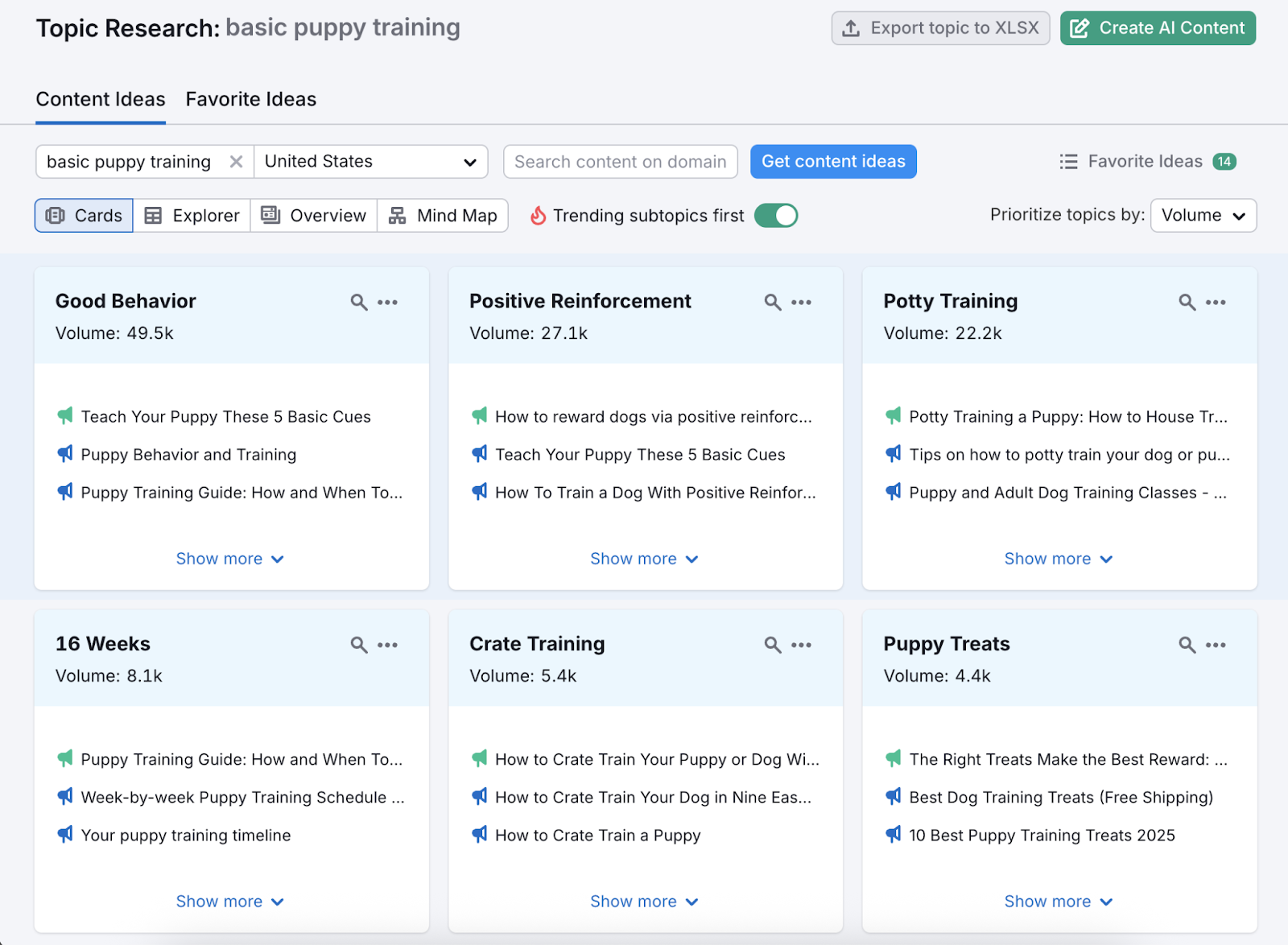
Click any card to see headline ideas, related questions, and related searches.
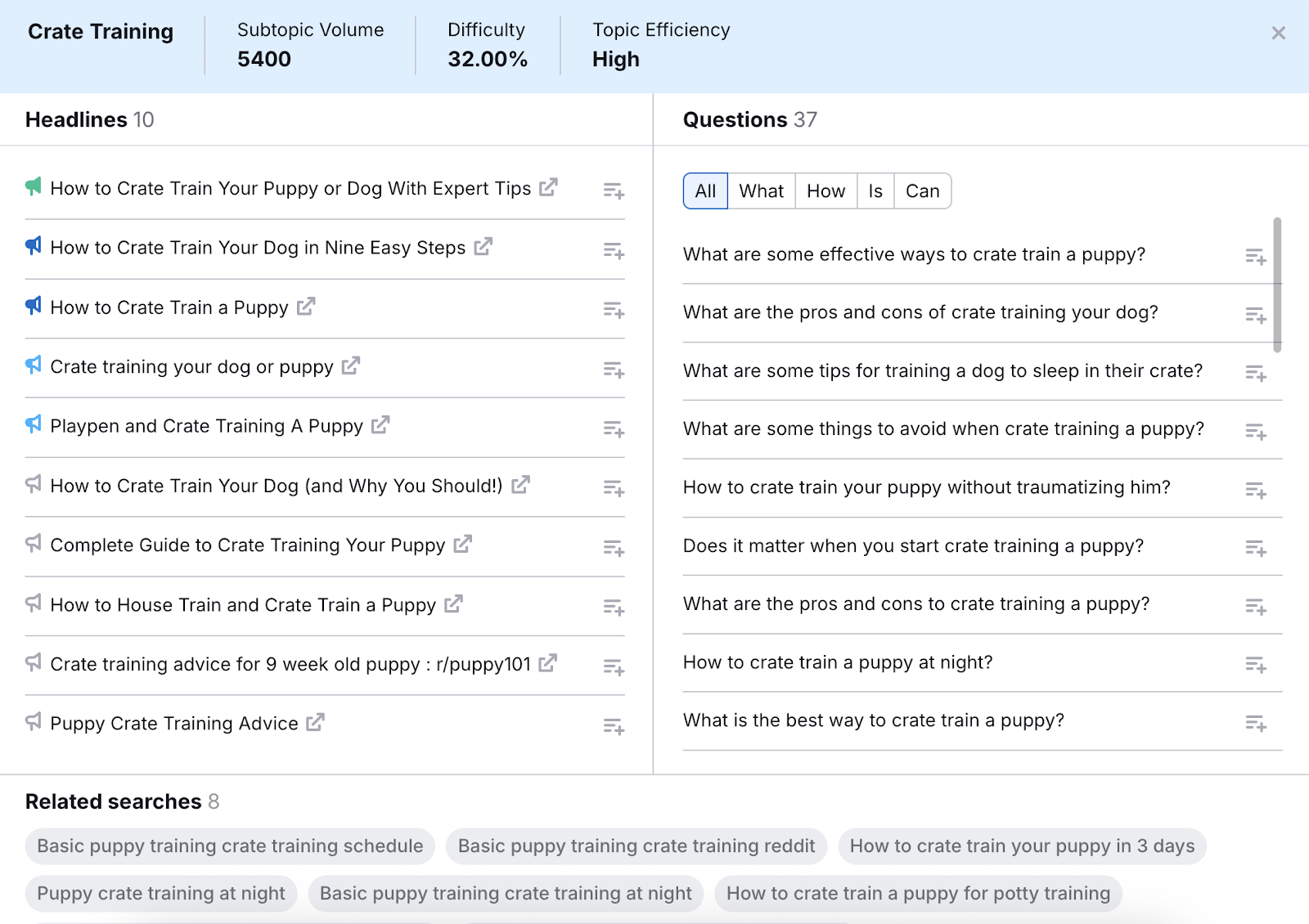
You’ll also see data that can help you determine whether a subtopic is worth covering in a blog post.
Like:
- Subtopic volume: The average number of monthly Google searches for the topic. The higher this number, the more eyes you may be able to get on your blog post (if it ranks well).
- Topic difficulty: How difficult it is to rank for the topic in Google SERPs on a scale out of 100%. The higher this percentage, the more competitive the topic is.
- Topic efficiency: A measure of a subtopic’s search volume relative to its difficulty. High efficiency means the topic has good search volume and isn’t too competitive.
When you find a headline you like, click the “+” sign to add it to your favorites.
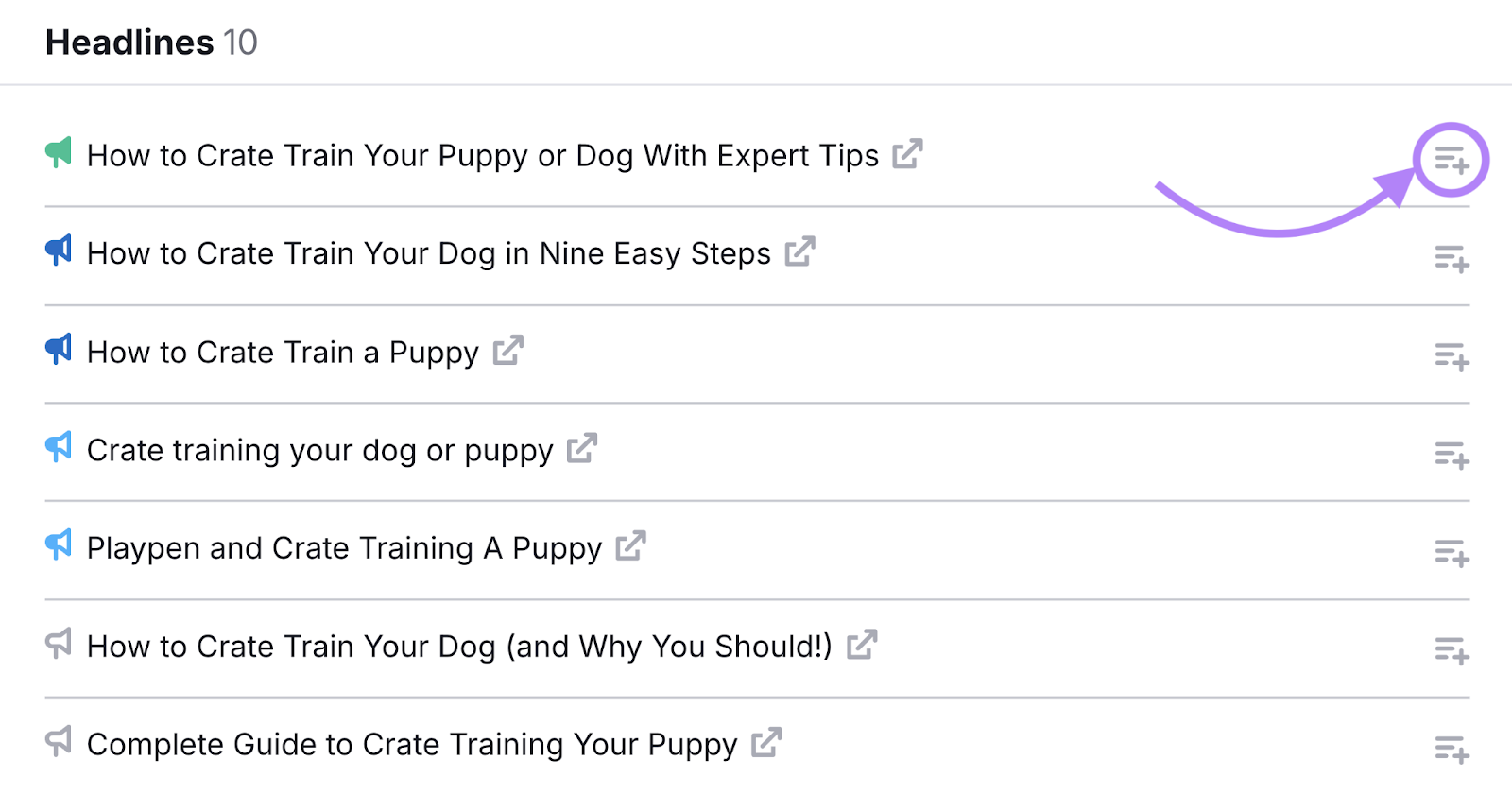
Then reference your favorites later when you need inspiration for blog subject ideas.
Perform Keyword Research
Keyword research helps generate blog ideas by revealing what users commonly search for on Google.
Use Semrush’s Keyword Magic Tool to start researching keywords. Enter a topic and your homepage URL, select your target location, and click “Search.”
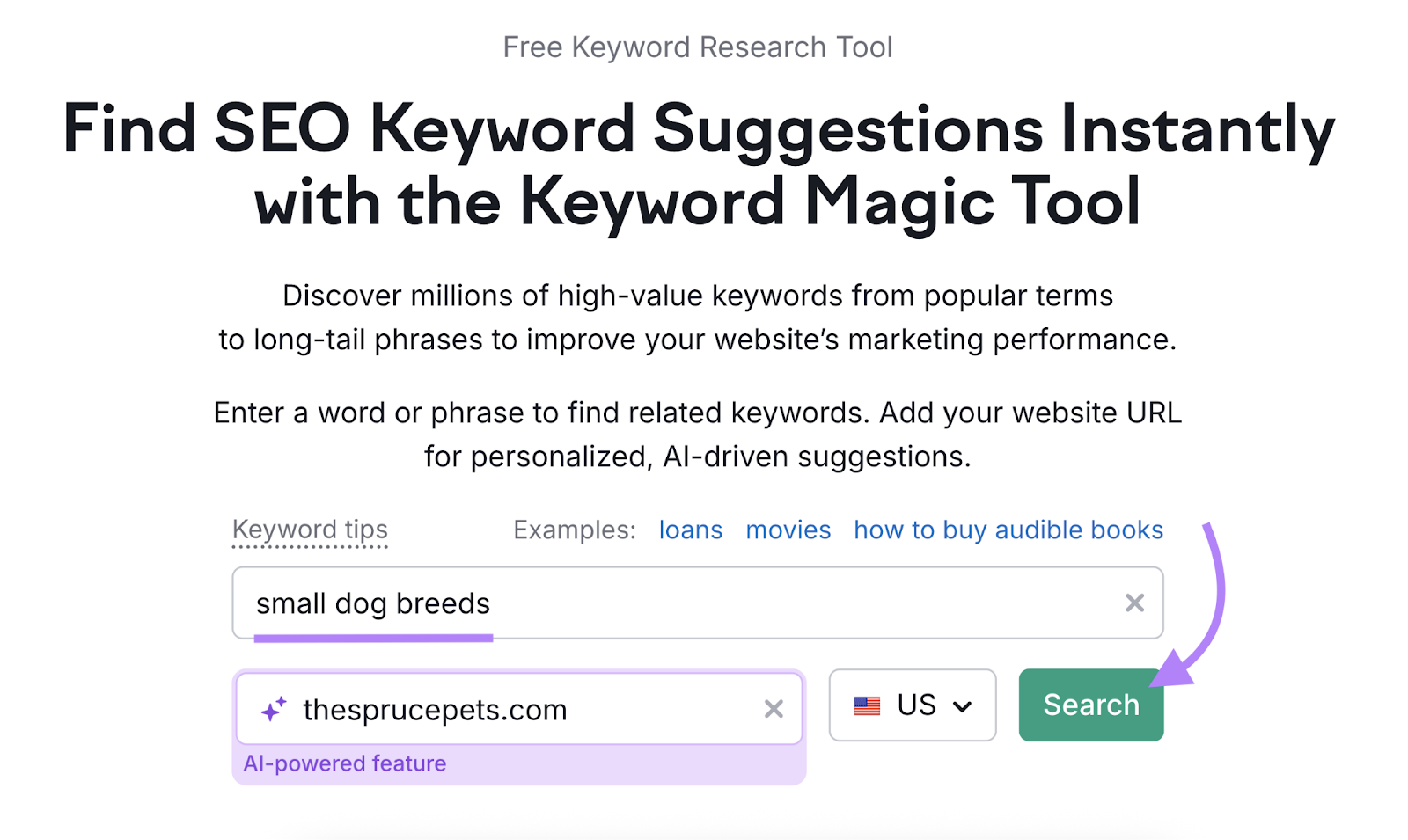
You’ll see a list of keywords users search for. There can be potentially thousands of related keywords, depending on your topic.
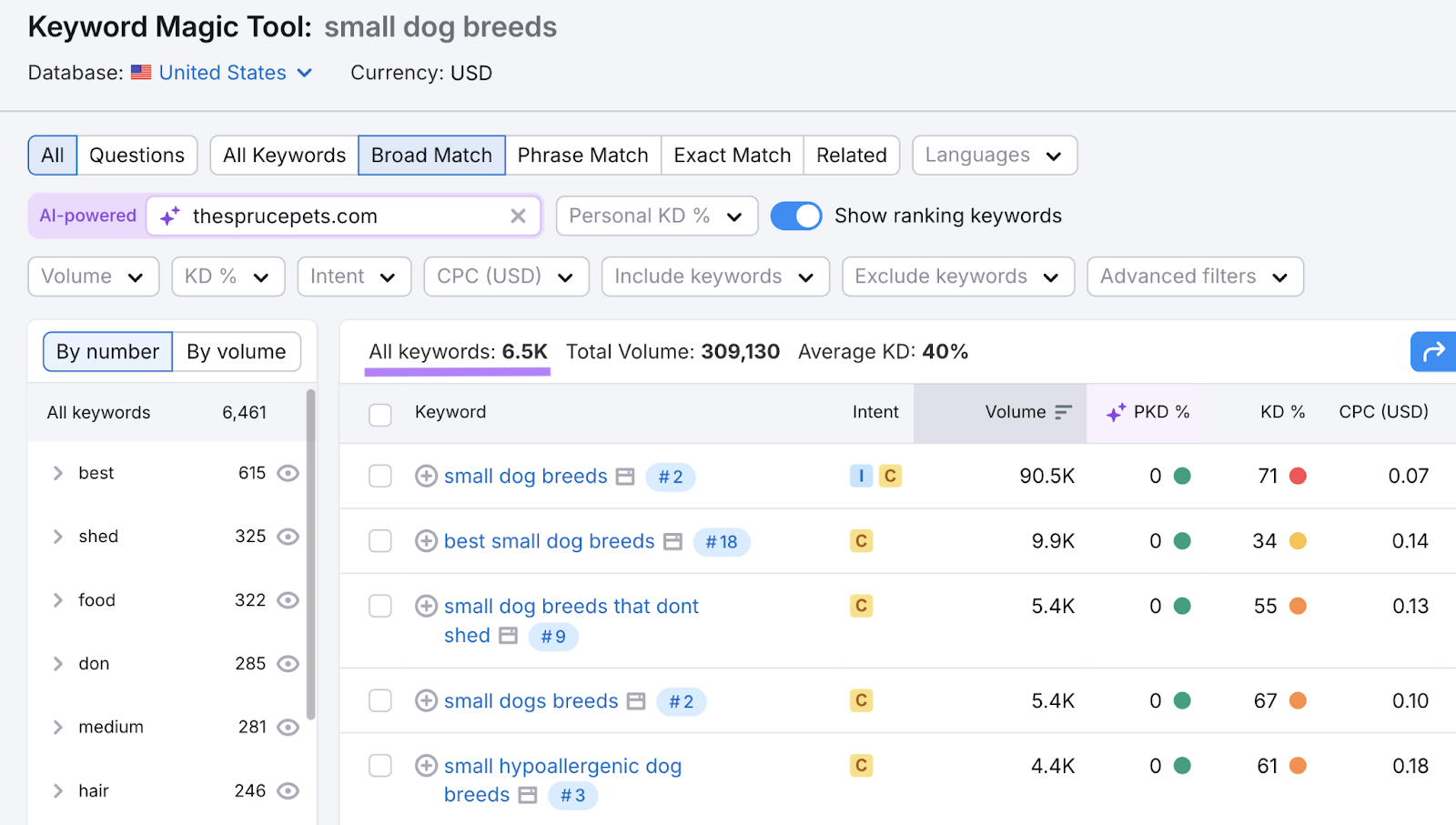
So, you’ll need to narrow down your list. Start by focusing on low-competition keywords.
Click the “Personal KD %” filter and choose “Very easy.” This will narrow your list to the easiest keywords for your specific website.
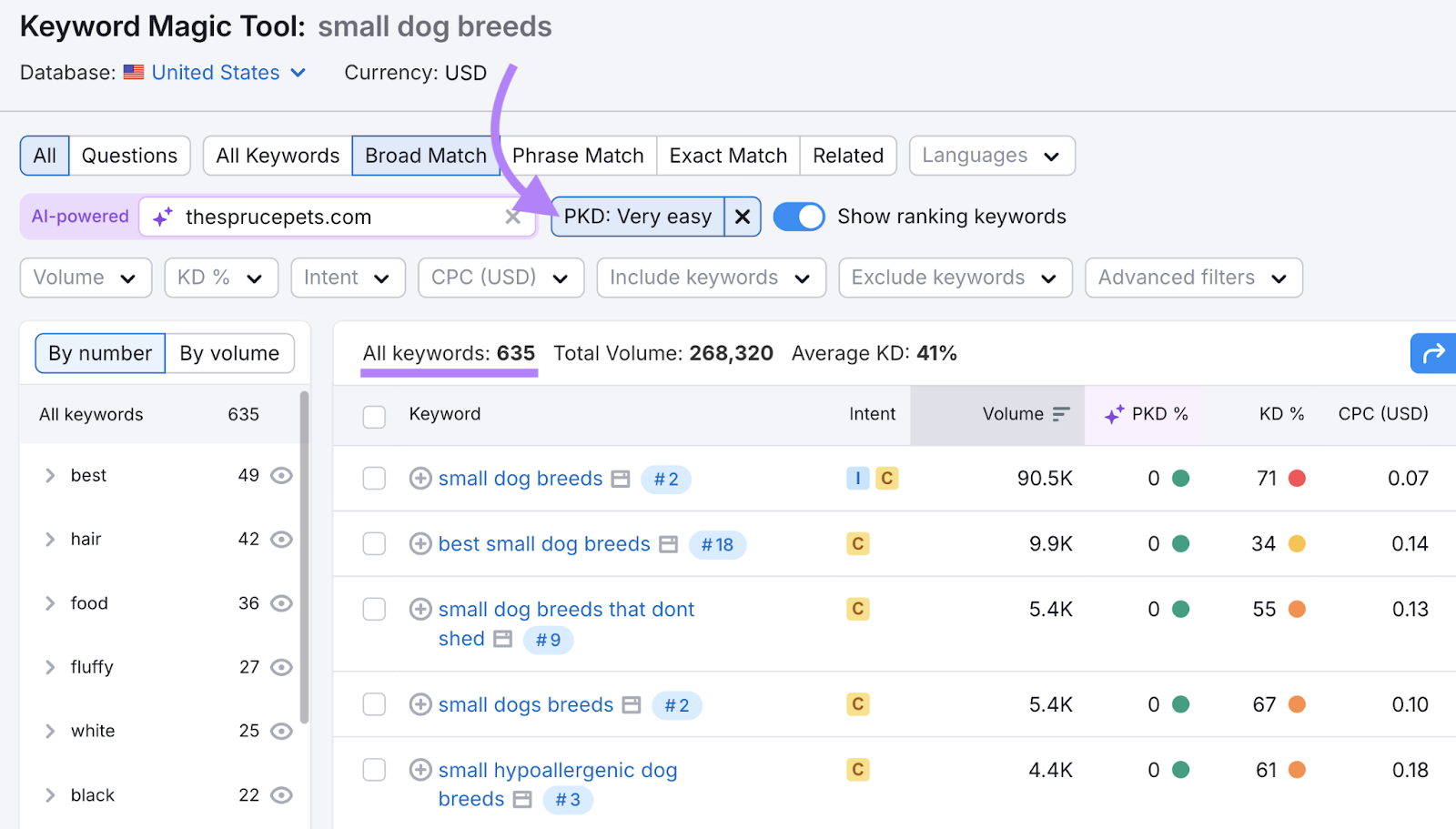
Then, set the “Volume” filter to show keywords with at least 100 searches.That way, you’ll only see keywords that have a good number of users searching for them.
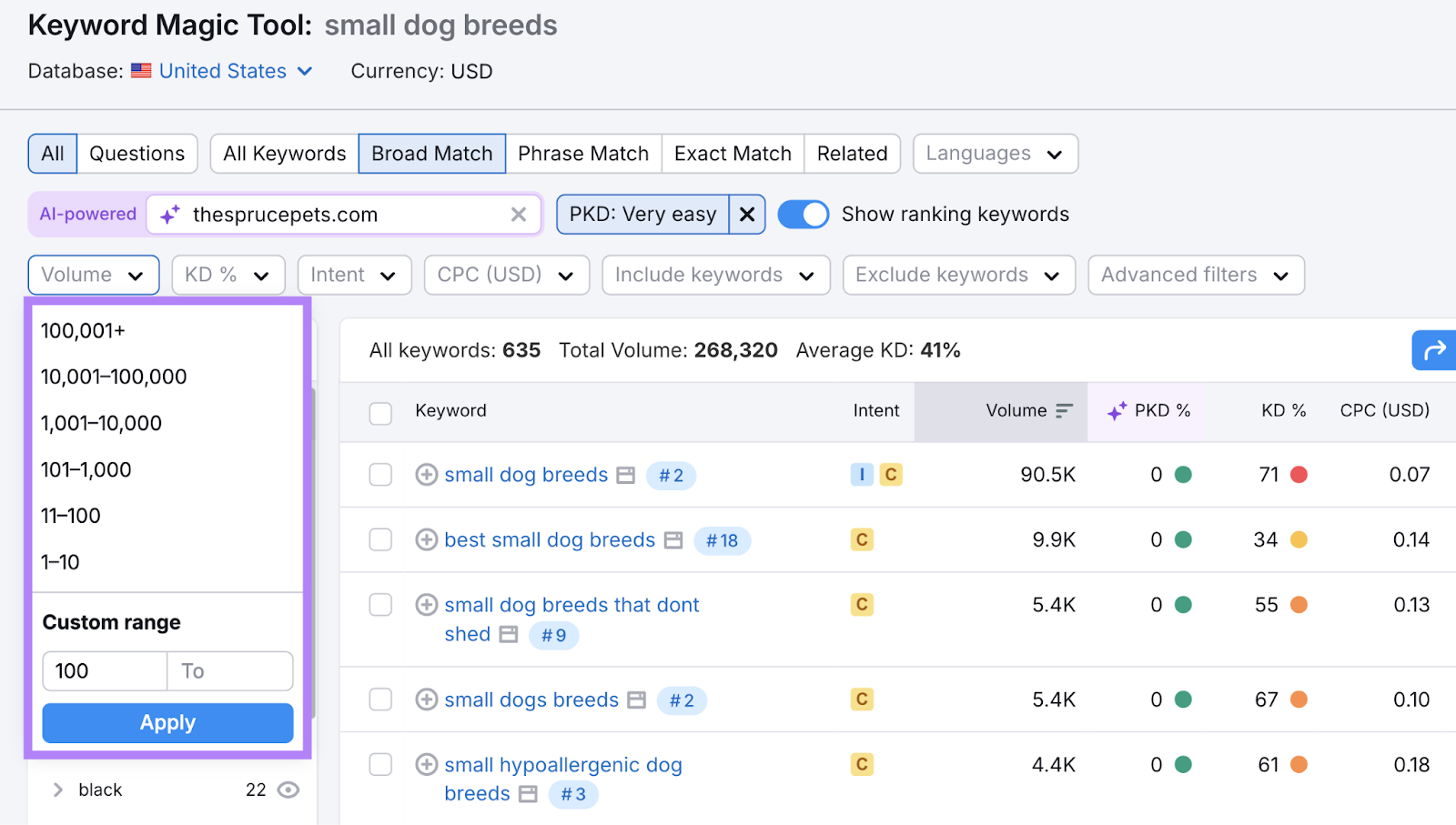
If any keywords spark a blog idea, click the “+” sign to add them to a list.
Give the list a name. And then reference it later when refining your idea further.
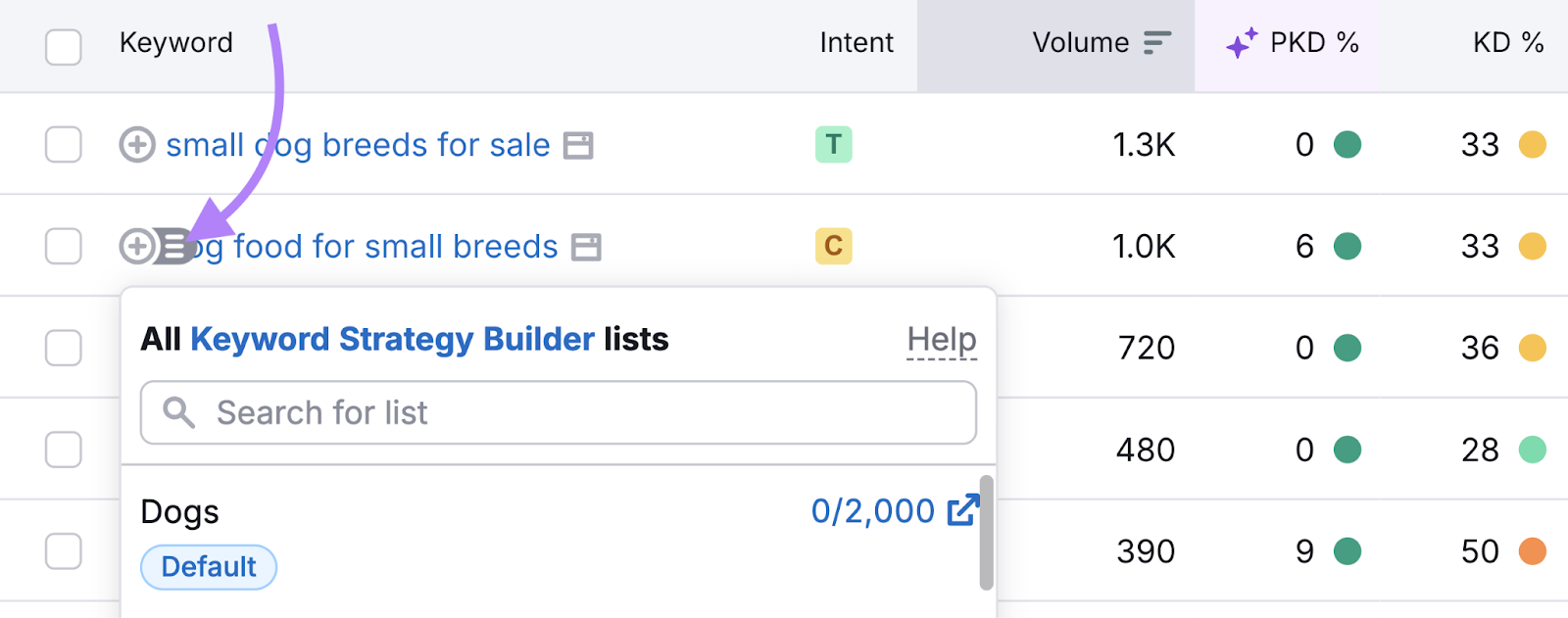
Ask Your Readers
Asking your readers what topics they’re interested in or what questions they have can lead to multiple blog ideas.
You can ask them by:
- Sending out a request to your email subscribers
- Polling your followers on social media platforms (e.g., Facebook, X, etc.)
- Embedding (or linking to) a survey on your site using tools like SurveyMonkey or Google Forms
This can help you generate ideas you know at least some of your audience is interested in. Which may lead to posts that get more clicks, views, or engagement.
Start Writing Your Next Blog Post
Once you have a blog idea, use the Semrush Content Toolkit to speed up the process of writing your post.
Create a content brief for your blog post using SEO Brief Generator. Or generate an entire article from scratch with the AI Article Generator. And then start writing or rewriting from there.
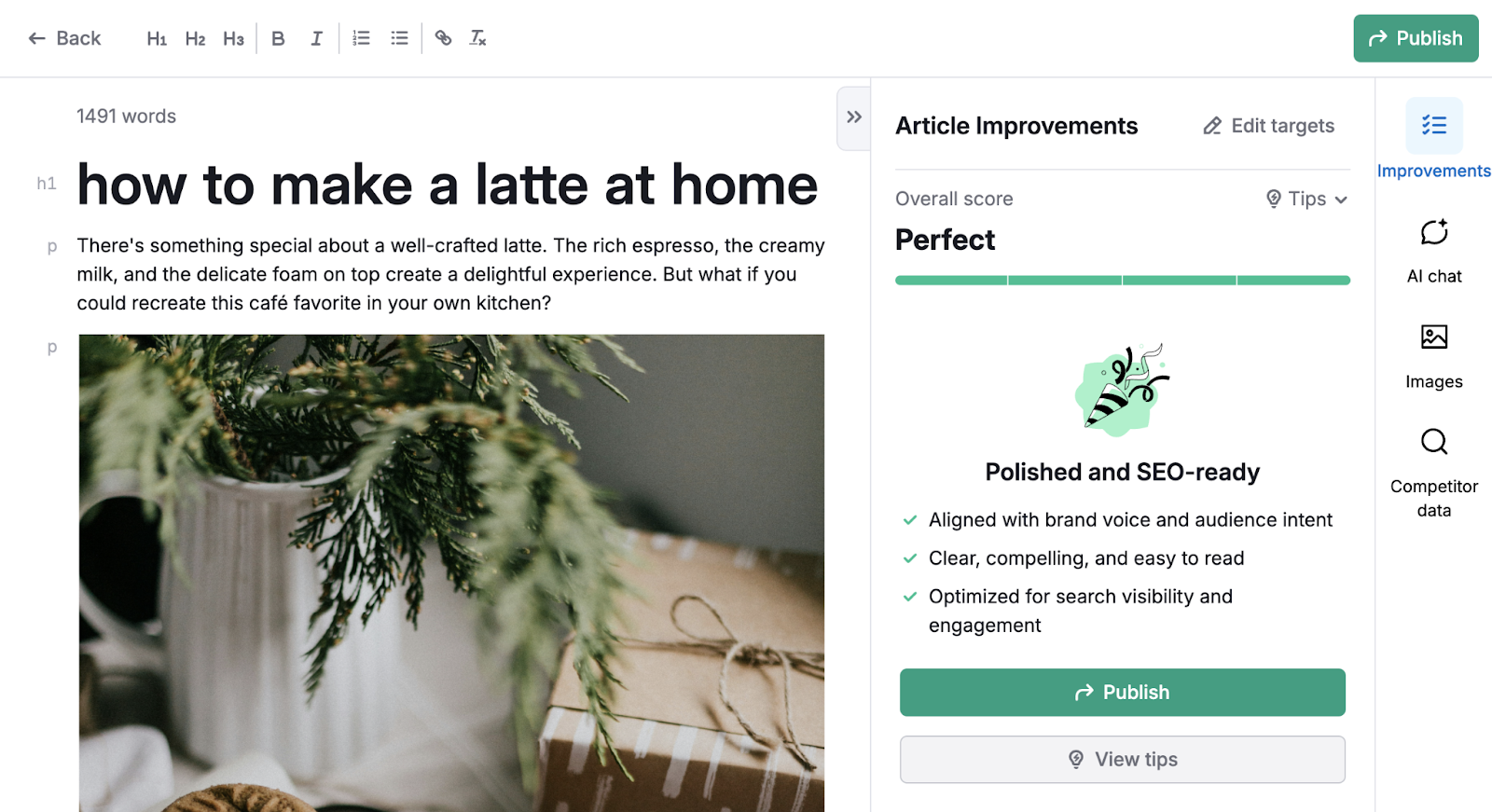
Try the Content Toolkit today.